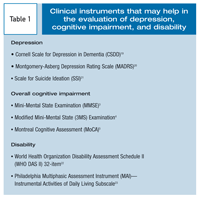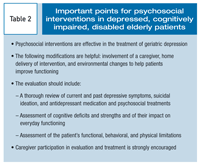
Publication
Article
Psychiatric Times
Psychosocial Interventions for Depressed Older Adults With Cognitive Impairment and Disability
Author(s):
Depression, cognitive impairment, and disability often coexist in older adults. Therefore, to effectively treat late-life depression, clinicians need to evaluate the presence and degree of the patient’s cognitive deficits and level of disability.

Depression, cognitive impairment, and disability often coexist in older adults. Therefore, to effectively treat late-life depression, clinicians need to evaluate the presence and degree of the patient’s cognitive deficits and level of disability.
This article highlights the importance of psychosocial interventions in the treatment of depressed, cogni-tively impaired, and disabled older adults; describes existing psychosocial interventions for this population; and presents a case illustration of problem adaptation therapy (PATH). PATH is a novel home-delivered intervention that aims to reduce both depression and disability in depressed older adults with significant cognitive impairment (including mild to moderate dementia) and disability.1,2
Clinical evaluation
Assessment of depression. The clinician must conduct a thorough evaluation that includes a review of the current depressive symptoms, past history of depression, history of pharmacological and psychosocial treatments and their effectiveness, and an evaluation of suicidal ideation. For most cognitively impaired elders, the clinician needs to interview the caregiver and obtain information that may not be available with the patient self-report. Instruments that have been validated in the assessment of depression in cognitively impaired elders may help in the evaluation (Table 1).

Because depressed elderly patients often do not report depressed mood but do report lack of interest or pleasure in activities, the clinician needs to use the patient’s language and experience in making an evaluation. Sometimes depressed older adults use words other than “depression,” such as feeling blue, down, discouraged, and not motivated. Because geriatric depression may be comorbid with other illnesses, symptoms that are caused by depression must be differentiated from those of another illness. Sometimes this differentiation is extremely difficult, because depression may exacerbate existing physical symptoms.
Assessment of cognitive impairment. An important aspect of the evaluation is the assessment of cognitive impairment. The clinician may ask the patient and the caregiver about the effects of cognitive difficulties on the patient’s functioning and identify cognitive strengths as well as deficits. Specific questions about the patient’s ability to start and stay with a new task until it is completed, to sustain attention and concentrate while reading or speaking with others, and to remember recent events and conversations may provide important infor-mation about the patient’s everyday functioning.
Screening tools such as the Mini-Mental State Examination (MMSE) may help identify overall cognitive impairment, but they are generally not sensitive to executive deficits or mild cognitive impairment.3 A somewhat more inclusive measure is the Modified Mini-Mental State Examination-the extended version of the well-known MMSE.4 Another screening instrument that has shown increased sensitivity to milder forms of cognitive compromise is the Montreal Cognitive Assessment (MoCA).5 (The complete MoCA test, as well as normative data and instructions for use, is available online at http://www.mocatest.org.) Translations into multiple languages are also available. These cognitive screening instruments can be administered with minimal training.
CHECKPOINTS
? Despite the effectiveness of pharmacological treatments in the acute phase of late-life depression, symptom remission is achieved in fewer than 40% of elderly depressed patients with cognitive impairment, with or without dementia. Therefore, effective psychosocial interventions for this population are needed. However, most psychosocial interventions for the acute treatment of geriatric major depression are designed for “young-old,” cognitively intact, ambulatory patients who can follow outpatient treatment plans.
? To treat depressed older patients with comorbid cognitive impairment and disability, psychosocial interventions need to be modified to include involvement of a caregiver, home delivery of the interventions, and environmental changes to help improve everyday functioning. With these modifications, psychosocial interventions may provide relief to a large group of elderly patients with depression who may not respond to antidepressant medication treatment.
Instruments that are administered in the context of a formal neuropsychological evaluation can provide a more accurate evaluation of cognitive deficits; ie, a score of 130 on the Mattis Dementia Rating Scale has a 98% sensitivity and 97% specificity for the diagnosis of Alzheimer dementia.6,7 Neurocognitive assessment conducted by a neuropsychologist provides assessment of the patient’s cognitive strengths and weaknesses that is interpreted in the context of the patient’s premorbid functioning, age, ethnicity, and education, and can yield essential knowledge that contributes to treatment success.
Assessment of functioning. In addition to the assessment of depression and cognitive impairment, the clinician needs to evaluate the patient’s functional, behavioral, and physical limitations (eg, hearing, visual, mobility problems). Information must be collected from both the patient and the caregiver; careful questioning may identify and evaluate discrepancies in their reports. The clinician evaluates how depression, cognitive impairment, and disability have affected the patient’s everyday functioning (ie, what activities the patient can no longer do; what the patient’s past and current pleasurable activities are; what effects, if any, the patient’s cognitive difficulties may have had on taking medication and performing activities of daily living). Available clinician-administered instruments may be helpful in providing information on the patient’s functioning (Table 1).
Treatment interventions
Despite the effectiveness of pharmacological treatments in the acute phase of late-life depression, symptom remission is achieved in fewer than 40% of elderly depressed patients with cognitive impairment, with or without dementia.8-11 Therefore, effective psychosocial interventions for this population are needed. Despite this need, most psychosocial interventions for the acute treatment of geriatric major depression are designed for “young-old” (average age, 65 to 70 years), cognitively intact, ambulatory patients who can follow outpatient treatment plans.12 To effectively treat depressed older patients with comorbid cognitive impairment and disability, these psychosocial interventions need to be modified (eg, involvement of a caregiver; home delivery of the psychosocial intervention; environmental changes to help depressed, cognitively impaired older adults improve their everyday functioning). The following interventions have been designed for depressed older patients with varying degrees of cognitive impairment.
Problem-solving therapy for mild executive dysfunction (PST-ED). PST-ED is a 12-week outpatient treatment for ambulatory depressed elders with mild executive dysfunction. It consists of 7 problem-solving stages and helps the patient identify his or her problems and find the best possible solution by learning the problem-solving stages and applying them to future problems. PST-ED has been found to be effective in reducing depression and disability in this population.13,14
Interpersonal psychotherapy for mild cognitive impairment (IPT-CI). IPT-CI has been modified for depressed elderly patients with mild cognitive impairment. Modifications include the systematic incorporation of concerned caregivers into the treatment process; joint patient-caregiver sessions help promote better understanding, communication, and respect.15,16 Finally, the IPT-IC therapist helps the dyad (patient and caregiver) adjust to their role transition as a result of the patient’s cognitive deficits and impaired functioning.
Cognitive-behavioral therapy (CBT) for mild dementia. Although CBT has been adapted for depressed elderly patients with mild dementia, no efficacy data are available.17 During the 16 to 20 sessions, comprehensive neuropsychological test data are used to assess the cognitive capabilities of the patient. In addition, behavioral activation interventions are used in conjunction with memory aids (eg, notepads, audio recording of sessions). These interventions are also used to examine the evidence for and against a negative thought and to try out new attitudes and cognitions in stressful situations.17
Behavioral treatment for depression in moderate to severe dementia. In a randomized trial, a behavioral treatment that taught caregiver strategies designed to increase patients’ pleasant events or to help with problem-solving skills reduced depressive symptoms in elderly patients with major or minor depression and moderate to severe dementia.18 This treatment is the recommended psychosocial intervention for elderly patients who are depressed and have symptoms of advanced dementia.
Problem adaptation therapy. This is a new 12-week, home-delivered intervention developed to treat late-life major depression comorbid with significant cognitive impairment (including mild to moderate dementia) and disability.1 PATH focuses on the patient’s ecosystem, which involves the patient-caregiver dyad, and the patient’s home environment. Appropriate strategies are assessed and planned in the patient’s living environment, where patients experience most of their difficulties. PATH imparts problem-solving skills by using problem-solving therapy as its basic framework to promote adaptive functioning.
Pragmatic and readily available environmental adaptation tools, including calendars, checklists, notepads, signs, and timers, are integrated into the therapy. Finally, caregivers participate in the problem-solving process and the use of environmental adaptation tools, and assist in engaging and directing the patient to pleasant events. The PATH therapist must use the patient’s remaining cognitive strengths and promote independence and, at the same time, find effective ways to bypass the patient’s cognitive deficits and behavioral and functional limitations.
The case vignette describes how PATH can be helpful in the treatment of patients with depression and comorbid cognitive impairment and disability. It also illustrates the complexity of depression treatment in this population. Even though PATH is a home-delivered intervention that requires evaluation of the patient’s actual environment, in certain cases, it can be provided in outpatient settings with the help of a caregiver.
CASE VIGNETTE
Mrs Y, an 82-year-old woman, became severely depressed following surgery for a hip fracture. Her cognitive functioning had decreased in the previous year. Her depression was characterized by depressed mood, lack of energy or interest in activities, psychomotor retardation, anhedonia, and concerns that she would never be herself again. Her MMSE score was 24 and her Dementia Rating Scale score was 128.3,6 Her executive functioning was significantly impaired, and she had mild memory and attention deficits. Mrs Y felt lost and was unable to perform activities that she performed regularly before surgery, including shopping, cooking, paying bills, and arranging social and family activities for herself and her husband. Mrs Y’s behavioral change affected her care. She could not organize her schedule to go to the rehabilitation center and to keep her primary care appointments. When her husband arranged house calls by a physical therapist, Mrs Y was not able to follow the recommended physical therapy exercises.
A clinician familiar with PATH visited Mrs Y to discuss the nature of her depression, redefine some complaints as symptoms of her depression, and explain how PATH could help both her depression and her disability. Mrs Y, her husband, and the therapist developed a list of Mrs Y’s problems. Among them, Mrs Y decided to target her inability to perform physical therapy exercises and her lack of social activities. For the first problem, Mrs Y indicated that she was disorganized, did not set a time for her exercises, and failed to memorize their sequence. The therapist suggested that Mrs Y always perform her exercises at the same time every day (10:30 am) and created a schedule of activities that would help her get ready for her exercises. The PATH therapist asked Mrs Y’s physical therapist to give Mrs Y only 2 exercises initially and to increase the number of exercises progressively. The physical therapist also provided Mrs Y with written instructions. Within the next 4 weeks, Mrs Y was able to perform 4 exercises daily.
As Mrs Y started progressing with her physical exercises, she, her husband, and the therapist started exploring the reasons for the lack of social activities. Mrs Y had not seen her family and friends because she found it difficult to get motivated and organized. She agreed to go to her daughter’s upcoming birthday party, which would provide the opportunity to reconnect with her daughter’s family and other friends. In addition, the party could serve as a stepping-stone for a broader plan of social activities. The plan involved buying a gift for her daughter. Mrs Y was uncertain of what to buy and where to buy it. Her homework assignment, therefore, was to work with her husband and create a list of pros and cons for possible gifts and stores. Working with her husband, Mrs Y was able to overcome her lack of motivation and buy a gift. She went to her daughter’s birthday party and was happy to see her family and especially her grandchildren.
During the next session, the therapist, Mrs Y, and her husband made a plan for pleasurable activities for the following weeks. These successes facilitated her rehabilitation, enhanced her self-esteem, and reduced her hopelessness. A few weeks after the intervention, Mrs Y’s depressive symptoms subsided, and she reported a better quality of life.

Conclusions
Psychosocial interventions are critical for elderly patients with depression who have cognitive impairment and disability because antidepressants provide symptom remission in fewer than 40% of patients. Psychosocial interventions must evaluate and target not only depression but also cognitive impairment and disability (Table 2). Therefore, appropriate modifications may be necessary: involvement of a caregiver, home delivery of the intervention (if possible), and environmental changes to help the patients improve their functioning. With these modifications, psychosocial interventions may provide relief to a large group of elderly patients with depression who may not respond to antidepressant medication treatment.
References:
References
1. Kiosses DN, Teri L, Velligan DI, Alexopoulos GS. A home-delivered intervention for depressed, cognitively impaired, disabled elders. Int J Geriatr Psychiatry. 2010 Jul 21; [Epub ahead of print].
2. Kiosses DN, Arean PA, Teri L, Alexopoulos GS. Home-delivered Problem Adaptation Therapy (PATH) for depressed, cognitively impaired, disabled elders: a preliminary study. Am J Geriatr Psychiatry. In press.
3. Folstein MF, Folstein SE, McHugh PR. “Mini-mental state.” A practical method for grading the cognitive state of patients for the clinician. J Psychiatr Res. 1975;12:189-198.
4. Teng EL, Chui HC. The Modified Mini-Mental State (3MS) examination. J Clin Psychiatry. 1987;48:314-318.
5. Nasreddine ZS, Phillips NA, Bédirian V, et al. The Montreal Cognitive Assessment (MoCA): a brief screening tool for mild cognitive impairment. J Am Geriatr Soc. 2005;53:695-699.
6. Jurica PJ, Leitten CL, Mattis S. Dementia Rating Scale-2): Professional Manual. Lutz, FL: Psychological Assessment Resources, Inc; 2001.
7. Monsch AU, Bondi MW, Salmon DP, et al. Clinical validity of the Mattis Dementia Rating Scale in detecting dementia of the Alzheimer type. A double cross-validation and application to a community-dwelling sample. Arch Neurol. 1995;52:899-904.
8. Rajji TK, Mulsant BH, Lotrich FE, et al. Use of antidepressants in late-life depression. Drugs Aging. 2008;25:841-853.
9. Alexopoulos GS. Depression in the elderly. Lancet. 2005;365:1961-1970.
10. Lyketsos CG, DelCampo L, Steinberg M, et al. Treating depression in Alzheimer disease: efficacy and safety of sertraline therapy, and the benefits of depression reduction: the DIADS. Arch Gen Psychiatry. 2003;60:737-746.
11. de Vasconcelos Cunha UG, Lopes Rocha F, Avila de Melo R, et al. A placebo-controlled double-blind randomized study of venlafaxine in the treatment of depression in dementia. Dement Geriatr Cogn Disord. 2007;24:36-41.
12. Mackin RS, Areán PA. Evidenced-based psychotherapeutic interventions for geriatric depression. Psychiatr Clin North Am. 2005;28:805-820, vii-viii.
13. Alexopoulos GS, Raue P, Areán P. Problem-solving therapy versus supportive therapy in geriatric major depression with executive dysfunction. Am J Geriatr Psychiatry. 2003;11:46-52.
14. Areán PA, Raue P, Mackin RS, et al. Problem-solving therapy and supportive therapy in older adults with major depression and executive dysfunction. Am J Psychiatry. 2010 Jun 1; [Epub ahead of print].
15. Miller MD, Reynolds CF 3rd. Expanding the usefulness of interpersonal psychotherapy (IPT) for depressed elders with co-morbid cognitive impairment. Int J Geriatr Psychiatry. 2007;22:101-105.
16. Miller MD. Using interpersonal therapy (IPT) with older adults today and tomorrow: a review of the literature and new developments. Curr Psychiatry Rep. 2008;10:16-22.
17. Teri L, Gallagher-Thompson D. Cognitive-behavioral interventions for treatment of depression in Alzheimer’s patients. Gerontologist. 1991;31:413-416.
18. Teri L, Logsdon RG, Uomoto J, McCurry SM. Behavioral treatment of depression in dementia patients: a controlled clinical trial. J Gerontol B Psychol Sci Soc Sci. 1997;52:P159-P166.
19. Alexopoulos GS, Abrams RC, Young RC, Shamoian CA. Cornell Scale for Depression in Dementia. Biol Psychiatry. 1988;23:271-284.
20. Montgomery SA, Asberg M. A new depression scale designed to be sensitive to change. Br J Psychiatry. 1979;134:382-389.
21. Beck AT, Kovacs M, Weissman A. Assessment of suicidal intention: the Scale for Suicide Ideation. J Consult Clin Psychol. 1979;47:343-352.
22. World Health Organization. WHO Disability Assessment Schedule II (WHO DAS II). http://www.who.int/classifications/icf/whodasii/en/index.html. Accessed July 19, 2010.
23. Lawton MP, Moss M, Fulcomer M, Kleban MH. A research and service oriented multilevel assessment instrument. J Gerontol. 1982;37:91-99.
2 Commerce Drive
Cranbury, NJ 08512
All rights reserved.



